Implant - an artificial tooth root
An implant is a permanent replacement for a missing tooth. An implant screw is screwed into the jaw bone and replaces the missing tooth root. On the implant screw, a connector called an abutment is put, and an individually made dental crown, dental bridge or removable denture is attached to this abutment.
Can I have an implant?
Treatment with implant usually begins with a consultation with the dentist. The dentists Classensgade has extensive experience with aesthetic and reconstructive dental treatment and implanates are one of several possible things that are considered in relation to other alternatives. Treatment assumes that the bone in the area is suitable for inserting a screw. This is typically assessed on the point of view of an X-ray and clinical examination. If it is considered that the bone is not immediately suitable for insertion of an implant, a surgical bone build-up can be performed. As an alternative to an implant treatment, a prosthesis can be made or a bridgecan be made . A prosthesis is one or more artificial teeth that are attached to a substrate resting on the gum. A dental bridge is a number of dental crowns that hang together and are attached to there remaining neighboring teeth.
What is an implant?
An implant is made of titanium which is a very tissue-friendly material that the body does not
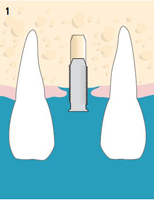
Implant on the way to being turned down in the hole in the bone
react negatively to (foreign object reaction). The dentist puts the implant by making a small incision in the gums and then pre-drilling a small standardized hole in the jaw bone with a specially calibrated drill. The implant can then be mounted in the prepared hole. On top of the implant is a small healing crumb that will usually poke through the gums. The gums can then be sewn back into place with a few stitches. Depending on which tooth it is replaced by the implant, a temporary smile prosthesis can be produced that can temporarily replace the missing teeth until a permanent implant-borne solution can be made. As a rule, the entire procedure takes between 1-2 hours.
After the implanate is set
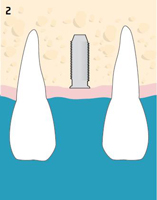
Implant in the bone
When the implant is stuck in the bone, something can be put on top. Down into the implant you put an intermediary also called an abutment. On top of this abutment you can then put what should look like teeth - either crowns or a removable prosthesis. As implant treatment has become more and more common, an incredible number of different brands of implants have come onto the market, some better than others. At Tandlægerne Classensgade we have chosen to use one of the oldest and most verified implant brands. We have done so because we believe that we will not compromise on the quality of the treatments we do. But quality costs - unfortunately. It is therefore easy to find dentists who offer treatment with implants cheaper than we do. However, you will not find dentists where the quality is higher.
What should I expect after implant surgery?
Swelling after implant surgery is quite common. It is a natural reaction from the body when it heals where the implant screw has been inserted. In addition, if you have had a bone build-up, the swelling will typically be greater. It is therefore important that you take the prescribed painkiller, as in addition to dampening any pain, it also counteracts swelling. In addition, you can put an ice pack or other cold on the cheek to dampen the swelling, in addition, you should keep your head high for the first hours after the procedure. How long after the procedure that you can start eating and drinking is individual and something you will be instructed thoroughly in when you are at the clinic.
The first weeks after implant surgery are extremely important for healing. Therefore, if bone building is to be done in connection with an implant treatment, medication will typically be prescribed. The medicine is due to the fact that you want to avoid inflammation in the area to create as optimal opportunities for bone formation as possible.
On the following link you can find our information for patients after they have had surgery: Guidance after surgical procedures
Painkillers for implant surgery
Before surgery, we recommend that you take some painkillers at the clinic. The surgeon will put a large amount of local anesthesia so that the procedure itself is completely painless. The anaesthetic will typically work 2-3 hours after the operation is complete. The painkillers you were given before surgery will thus work when local anaesthetic decreases. We recommend that you take the maximum dose of painkillers for the first 3-4 days - it is easier to keep the pain down than to fight them once they have occurred. In addition, as mentioned earlier, they help with the possible subsequent swelling. The typical preparations will be paracetamol (Panodil) and Ibuprofen.
Threads in the gums
Depending on the nature of the operation, the threads will either disappear by themselves in 15-20 days or you will have to go to the clinic and have the threads removed. In that case, the area will be controlled at the same time. How this should be done in the individual situation will be informed in connection with the intervention.
Abutment
Typically, it will take 2 -4 months for the implant to grow firmly in the bone. To check whether the bone has grown around the implant, an X-ray is taken and some clinical studies are done.
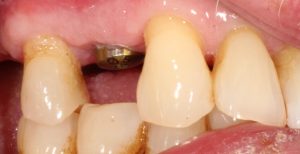
Healing screw through the gums before imprinting to the final abutment and crown.
If it is considered that the implant is stuck as expected, the abutment and crown/prosthesis can be attached.
The abutment acts as an intermediary from the implant in the bone and up to the crown or prosthesis. The abutment is attached to the implant with a small screw and is typically made of titanium just like the implant. In some cases, the implant is hidden under the gums during the healing period and therefore a small incision must be made in the gums so that you can get down to the implant and have access to put something on top.
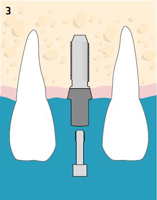
Abutment mounted on implant
To produce the individually produced tooth replacement - crown/bridge or prosthesis - an imprint of teeth and implant must be taken. If it is crowns or bridges to be made as the final solution to the implants, the final solution will typically be completed 2-3 weeks after the imprint is taken, while in some cases it takes a little longer if it is a removable prosthesis.
The crown, bridge or prosthesis of the implant
The crown or bridge is typically finished after 2-3 weeks from the time the imprint is taken. In the case of a very aesthetically demanding treatment, there will typically be 1 or 2 consultations with the dental technician who manufactures the crown. This so that they know exactly what color the tooth should have and that they can individualize it right to the individual case.

The final implanat crown mounted on the implant
Crowns and bridges are usually made of porcelain today, however, it is a matter of replacing many teeth, it may be possible to make a frame under the porcelain in a metal (titanium or Cobalt Chromium). The choice of material depends on the requirements in question in each situation. If a front tooth is to be replaced, they will weigh heavily on the selection of a high aesthetic material, while for the rear molars they apply that the material must be very chewy.
If the missing teeth are to be replaced by a prosthesis, there will typically already be a prosthesis which you then put push buttons in so that it gets firmly stuck and does not tilt or generally sit loosely.
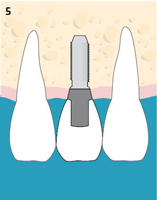
The crown attached to the implanata
In other cases, a completely new prosthesis is made after imprinting the implants. The individual treatment will be reviewed before starting treatment.
Oral hygiene after implant surgery
On the same day as implant surgery, we recommend that in the evening you skip tooth brushing and cleaning your teeth. The next day you can start with regular tooth brushing, but not in the operated area. Instead, rinse with a mouthwash called chlorhexidin (0.2%). Rinse twice a day for about 1 minute, keeping the liquid still in the area. Thus, nothing active should be "gargled" or otherwise done. After 1 minute, spit out the liquid. This will keep the area clean while the gums and bone around the implant are allowed to heal. Mouthwash should be made at least 1 week, but you will get further instruction in connection with the operation.
If you have received a temporary smile prosthesis, we recommend that you avoid using it at least 2 weeks after surgery. The prosthesis is kept clean by brushing it with a clean toothbrush with warm water and hand soap.
When rinsing with chlorhexidin no longer needs to be done, brushing can be done easily in the area. Teeth and gums in the area should be kept clean to avoid the risk of infection.
How do I keep clean about an implant?
It is very important that you keep a good clean around your new implants as good cleanliness is a prerequisite for a sustainable result. If the new teeth are not kept properly clean, inflammation of the gums and bone around the implant is at risk. This condition is called periimplantitis and results in loss of bone around the implant screw. This means that the implant is no longer properly located and the condition may ultimately end up having to remove the implant and the treatment has thus failed and needs to be resealed.
In general, clean should be kept in the same way as around ordinary teeth. This means that it is important both to brush with a regular toothbrush and to keep clean between the teeth/implants with small space brushes. What exactly needs to be done in the individual situation will be a talk we take in connection with the installation of the final construction. If in doubt, you are always welcome to contact the clinic and have a chat about how it would be best to keep clean in the given situation.
* Photos show treatment made at the Dentists in Classensgade.
** Illustrations borrowed from https://www.tandlaegeforeningen.dk/Patienter/sygdomme_og_gener_A-AA/G-K/implantat

